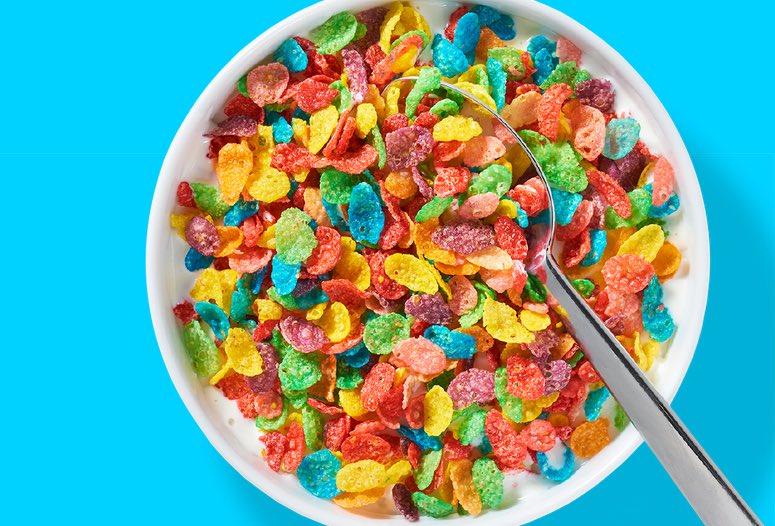From Glossier’s pink bubble wrap pouch to Augusta National, Inc.’s green jacket, the U.S. Patent and Trademark Office (“USPTO”) has been dealing in no small number of companies claiming trademark and trade dress rights in a color or a combination of colors. In one of the latest quests by a brand to claim exclusive rights in connection with its specific use of color – or better yet colors, Post Foods filed an application for registration with the USPTO early this month. What is the Lakeville, Minnesota-based manufacturer looking to protect? “The product configuration of crisp cereal pieces in the colors of yellow, green, light blue, purple, orange, red and pink.”
To be more specific, Post Foods – the entity behind an array of well-known cereal products, from Honey Bunches of Oats and Honey-Comb to Raisin Bran and Grape-Nuts – is seeking a registration for the colors of the pieces of its Fruity Pebbles cereal.
In the application, which it filed on April 2 (as first pointed out by trademark attorney Erik Pelton), Post Foods claims that it has been using this particular “product configuration” since November 1973, and in seeking a registration, is essentially asserting that consumers have come to view pieces of cereal in the colors “yellow, green, light blue, purple, orange, red and pink” as an indicator of the source of its cereal product. In other words, the colorful little pieces of rice-and-sugar cereal act as a trademark.
That secondary meaning in the minds of consumers linking the colored cereal to a single source is significant, as it is a well-established fact in trademark law that product configurations, such as pieces of cereal, are not “inherently distinctive” and thus, in order to claim exclusive rights in such marks, the registration-seeking party must show that the configuration has acquired distinctiveness. (This was one of the key takeaways in the Supreme Court’s decision in the 2000 case between Walmart and apparel-maker Samara Brothers).
With this in mind, Post Foods’ application will inevitably face pushback from the USPTO, requiring the company to establish acquired distinctiveness, which is typically proven by way of evidence of “advertising expenditures, sales success, length and exclusivity of use, unsolicited media coverage, and consumer studies (linking the [trademark] to a source).”
Other issues that are likely to stand in its way – at least preliminarily – when it comes to registration? Aesthetic functionality, the trademark doctrine that dictates that purely aesthetic features of a product that create a competitive advantage are categorized as functional and thereby, ineligible for trademark protection, as functionality is a bar to such protection. While these visual features are not traditionally “functional” or useful, they are considered functional because they are so attractive and thus, desirable to consumers as a result. In short: these design elements provide more of an aesthetic value that is pleasing to consumers than they serve a trademark function.
Reflecting on Post Foods’ colored cereal application, University of New Hampshire School of Law professor Alexandra J. Roberts cited the aesthetic functionality doctrine, noting that “when people buy rainbow-colored cereal because rainbow colors make them happy, not because rainbow-colored flakes serve as an exclusive source indicator for the brand they’re seeking,” that is an example of the doctrine in play.
Meanwhile, others have pointed to the existence of other cereals that make use of rainbow-hued pieces, which would likely mean that Post Foods will need to limit the breadth of its mark by being more specific in terms of its description. And even then, the existence of similar marks in the market (assuming, of course, that Post Foods is, in fact, using the pieces of cereal as indicators of source) just might lead the USPTO will simply say no as was the case for General Mills, after the USPTO’s Trademark Trial and Appeal Board (“TTAB”) asserted in a April 2017 decision that the cereal giant cannot claim exclusive rights in its Cheerios yellow.
In shooting down General Mills’ application, the TTAB asserted that while Cheerios has sold cereal in yellow boxes since the 1940s, the company did not provide sufficient evidence to support the claim that its iconic yellow box is an identifier of source for consumers, particularly given the extensive use of yellow on other cereal boxes, which made it more likely that consumers would view those boxes as “eye-catching ornamentation customarily used for the packaging of breakfast cereals generally,” rather than as an indicator of Cheerios as a source.
Not exactly a fashion-specific scenario, Post Foods’ quest for a trademark registration, nonetheless, shows the consistent emphasis by brands on a wide array of potential source-identifying symbols, which is readily moving beyond brand names and logos to additional elements, such as product packaging and product configurations, and the use of color in connection with them. Given the increasingly visual nature of the Instagram-age market and consumers, and in light of the crowded market and consistent increase in trademarks being used by consumers goods brands, the reliance on color as a way for a brand to distinguish itself and its products from others makes sense.











